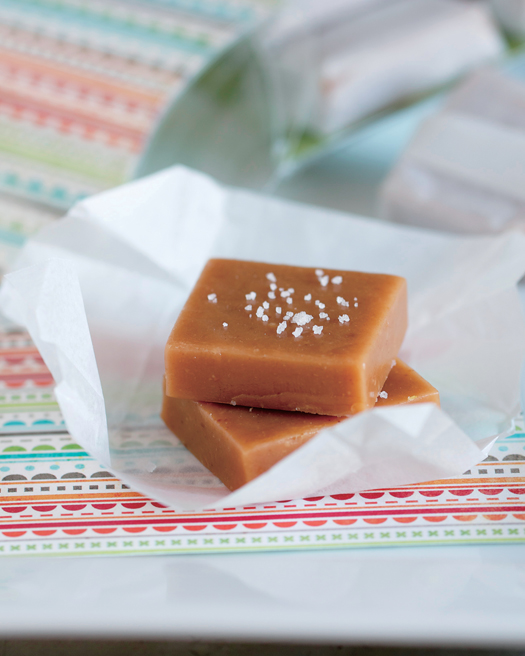RECIPES:
Cabbage and Kale Minestrone
Rustic Rosemary Olive Oil Bread
Whipple Scrumptious Fudgemallow Delight Bars
Sour Cream Caramels
I spent 10 percent of my youth in pursuit of candy. A short distance from our house, a small store shared a building with our neighborhood post office. Although the sign read “general store,” all the kids knew it as “the candy store,” “the beehive,” or, most often, and most affectionately, The Little Store.
The genius of The Little Store’s business model was certainly its proximity to the post office, and the mutually beneficial trade between parents and their children. On a daily basis, parents would send their children to mail off letters, buy stamps, and check post office boxes, all for whatever spare change was in their pockets. Basically, the neighborhood had a whole personnel of couriers who would work for pennies. And my friends and I gladly took the job. We would take several walks to The Little Store each week, filling brown paper sacks with as much candy as we could—Sour Patch Kids, Swedish Fish, Jolly Ranchers, Boston Baked Beans, and Mary Janes. We’d then stop back in at the post office to pick up the mail, and jam the letters in beside the candy.
So, when my teacher read Charlie and the Chocolate Factory to my second grade class, I could relate to Willy Wonka’s obsession with candy. That obsession remains. As much as I’d like to abandon my sugar cravings, they’re always with me, and apparently I’ve managed to pass them along to my kids. So I figure, until we manage to break free from our candy dependency, why not just embrace it?

For our little Candy Factory celebration, we read Charlie and the Chocolate Factory together and did some experimenting in the kitchen. Candy making is somewhat of an art and requires some patience and practice, so we started with the Whipple Scrumptious Fudgemallow Delight Bars—something the kids could make without much help. Once those were in the refrigerator, I demonstrated for them how to make homemade caramels. While the candy set, we had our lunch of Cabbage and Kale Minestrone and Rustic Rosemary Olive Oil Bread—a feast fit for Charlie Bucket and his family.
When hosting your own Candy Factory party, you can use these recipes or your own family favorites. Since most of the party will be spent in the kitchen learning a new skill, go over rules of safety together, such as keeping pot handles turned in, away from the reach of small children; keeping long hair tied back; and using potholders.
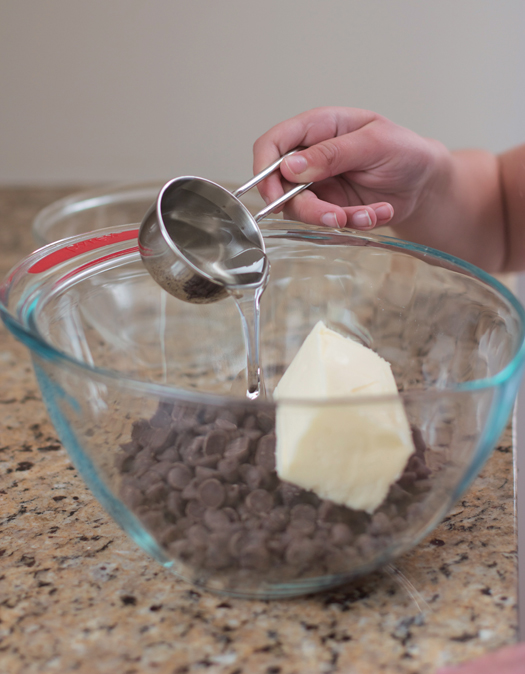
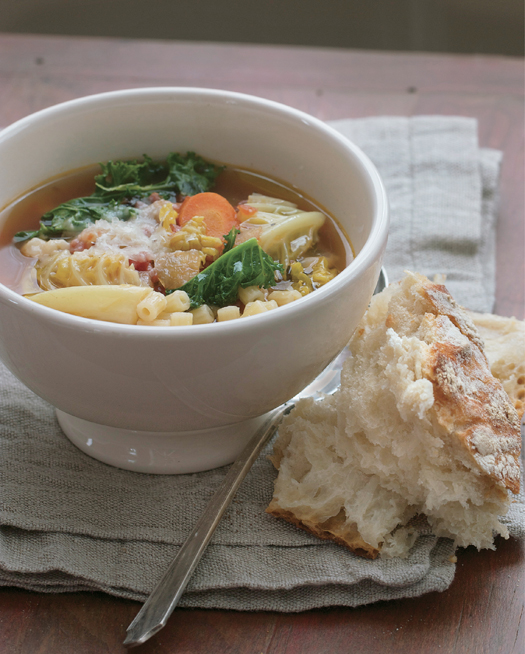
Cabbage and Kale Minestrone

The Bucket family, in Charlie and the Chocolate Factory, live on cabbage soup. I can’t think of a better or healthier contrast to the candy than a simple bowl of cabbage soup for our party. I added a few more vegetables to make it heartier. Serves 12
3 tablespoons good olive oil
1 large yellow onion, diced
1 shallot, diced
Pinch of kosher salt
Pinch of crushed red pepper flakes
2 cloves garlic, chopped
1 teaspoon dried thyme, or 2 teaspoons fresh thyme
2 bay leaves
4 cups low-sodium chicken broth or vegetable broth
1 (28-ounce) can diced tomatoes
1 (15-ounce) can white beans, such as cannellini or great northern, rinsed and drained
1 small head Napa cabbage, chopped
1 bunch kale, washed, ribs removed, and chopped
1 teaspoon balsamic vinegar
1⁄2 pound small pasta, such as tubettini or elbow macaroni, cooked al dente
Grated Pecorino Romano or Parmesan cheese, for garnish
- Heat oil in a large pot set over medium heat. Add onions and shallot, and sprinkle with salt. Raise heat to medium-high and cook, stirring often, until onions are tender and the edges turn very brown. Stir in pepper flakes, garlic, thyme, and bay leaves, and cook 1 minute more, being careful not to burn the garlic.
- Add broth and tomatoes and bring mixture to a boil, then lower heat to medium and allow to simmer for 20 minutes. Add beans and cabbage and cook for another 10 minutes. Right before serving, stir in kale and vinegar.
- Place a small amount of the cooked pasta into each bowl, ladle some of the soup on top, and garnish with Parmesan cheese.
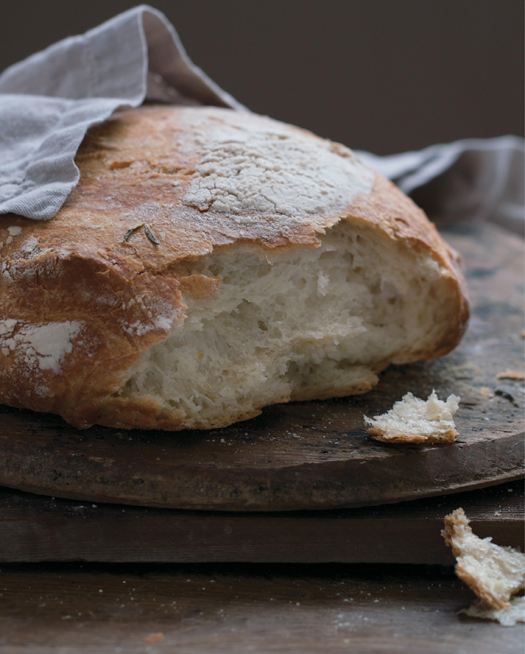
Rustic Rosemary Olive Oil Bread

This bread was inspired by Jim Lahey’s recipe for No-Knead Bread in the New York Times that took the foodie world by storm a few years ago and changed the way home cooks make bread. My recipe is different, but I could not have come up with it without his genius.
To make this, you will need a pot of some kind, with a lid, that can withstand a 450ºF oven. This could be a Dutch oven or a cast-iron pot with enamel coating, as long as the handles won’t melt at high temperatures. I have a special baking stone with a high lid that works beautifully. Makes 1 loaf
3 cups bread flour, plus more for dusting
1⁄4 teaspoon instant yeast
11⁄2 teaspoons kosher salt
11⁄4 cups lukewarm water
1⁄4 cup very good extra-virgin olive oil
1–2 tablespoons fresh rosemary leaves, chopped or left whole
2 tablespoons semolina or cornmeal for dusting the bottom of the pot
- In a large bowl, stir together flour, yeast, salt, water, olive oil, and rosemary. Cover bowl with plastic wrap and let sit for 18–20 hours.
- Dump dough onto a well-floured board. Take the same bowl that just held the rising dough and dust generously with more flour (the flour should stick to whatever moisture was left behind from the dough). Use very wet hands or a bench scraper to fold the outer edges of the dough into the center a few times to shape into a soft ball. Shape the dough into a taut lump, and return to the floured bowl. Sprinkle a little more flour around the edges of the dough. Cover with plastic, and let rise for 2 hours.
- While dough is rising, place the Dutch oven or covered pot in the oven, and preheat to 450ºF. When the oven comes to temperature, pull out the Dutch oven, lift the lid, and dust the bottom with semolina. Use a silicone spatula or a wooden spoon to ease the dough onto the semolina. Replace the hot lid, and place in the oven for 30 minutes. Remove the lid, and bake for 10 minutes more.
- Take the bread out of the pot, and place on a cooling rack for 10 minutes. Slice and serve with butter or olive oil.
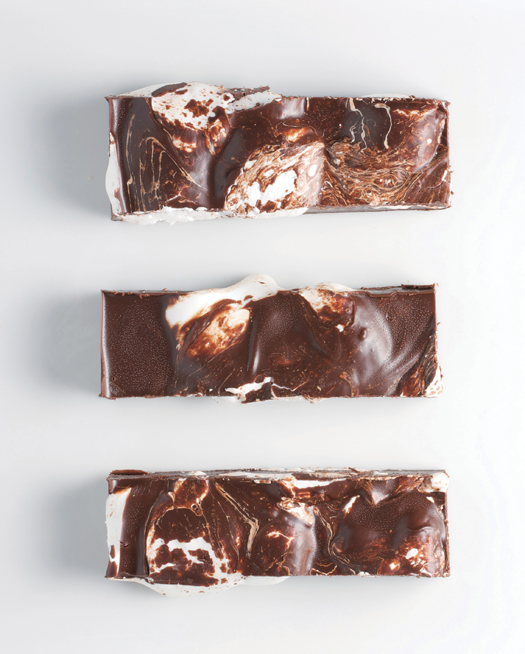
Whipple Scrumptious Fudgemallow Delight Bars

Could Roald Dahl have come up with a more enticing name for a chocolate bar? Anytime my kids and I read Charlie and the Chocolate Factory and we read about Whipple Scrumptious Fudgemallow Delight Bars, I have a sudden craving for one, but we’ve never found a store-bought candy that could live up to the name. I think these candy bars may just be the solution. This recipe is easy enough that older children can make it with minimal supervision. Makes 3 dozen candy bars
1 (12-ounce) bag (2 cups) semi-sweet chocolate chips
1 stick (8 tablespoons) unsalted butter
3 tablespoons corn syrup
Pinch of kosher salt
1 (7-ounce) jar (about 2 cups) marshmallow cream
- Line an 8 x 8-inch square pan with an 8 x 12-inch piece of parchment paper or wax paper so that the paper overlaps the sides of the pan. Hold in place with bulldog or binder clips.
- Pour chocolate chips, butter, corn syrup, and salt into a large microwave-safe bowl. Microwave on high for 45 seconds, stir, then microwave again for 30-second intervals, stirring well after each, until the chocolate is smooth and shiny.
- Spread half of the chocolate mixture in the bottom of the prepared pan. Drop marshmallow cream by spoonfuls onto the chocolate. Pour remaining chocolate on top, and use a butter knife to swirl the marshmallow cream into the chocolate. Refrigerate for 2–3 hours.
- Use a knife to cut the chocolate away from the edges of the pan, and use the excess parchment paper to carefully lift the candy from the pan. Use a sharp knife to cut into 36 squares.
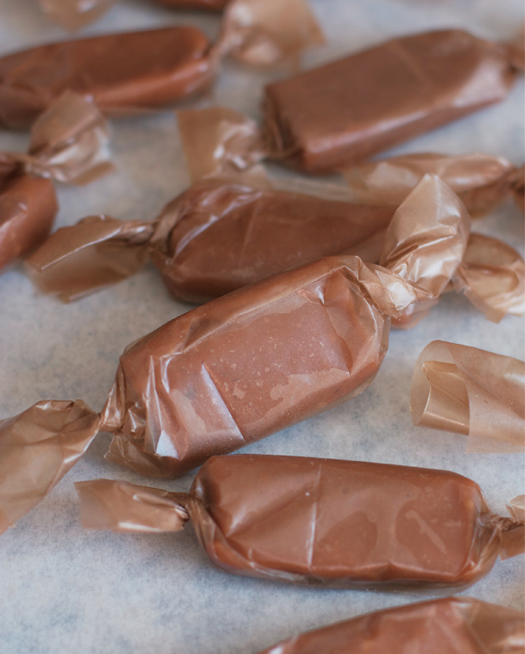
Sour Cream Caramels

Making caramel is a great way to really experience candy making. The secret is in the temperatures, but it also requires some timing, patience, and precision. Don’t panic if you make a mistake the first couple of times you try it. My first attempt at caramel burned, and I had to throw it out and start over. But eventually I got the hang of it.
This recipe requires stirring the caramel with the thermometer in the saucepan. I would recommend investing in a professional candy thermometer, which costs about $12 and can withstand getting knocked around in the pan a bit. The inexpensive glass models probably aren’t up to the task. Makes 32 candies
3 tablespoons sour cream
11⁄4 cups heavy cream
1 teaspoon pure vanilla extract
11⁄2 cups pure cane sugar
3 tablespoons corn syrup
1⁄4 cup water
1⁄2 teaspoon kosher salt or sea salt
3 tablespoons unsalted butter, at room temperature
- Line an 8 x 8-inch nonstick cake pan with an 8 x 12-inch piece of parchment paper so the edges come up and overlap the sides of the pan.
- In a large microwave-safe liquid measuring cup, combine sour cream, heavy cream, and vanilla. Microwave on high for about 60–90 seconds, until hot and almost bubbling. Keep at the ready.
- In a medium heavy-bottomed saucepan, stir together sugar, corn syrup, water, and salt. Set over medium-high heat, and stir occasionally until the syrup starts to bubble. Use a pastry brush dipped in water to brush any sugar crystals down the sides of the pan. Once the syrup bubbles, stop stirring. If you need to redistribute the heat, lift the pan and gently swirl the syrup around. Clip a candy thermometer to the side of the pan, and wait for the heat to reach 305ºF.
- Remove from heat, and with a long-handled wooden spoon, stir in warm cream mixture and butter. The mixture will bubble violently. Be careful and keep stirring. Return to the burner, and keep heat at medium-high. Stir constantly until caramel reaches 240ºF (soft ball stage), about 25 minutes. If you don’t have a candy thermometer, you can test the doneness by spooning a small amount of the caramel into a glass of cool water. When the candy sinks to the bottom and forms a ball that has the consistency of Silly Putty, you have reached the right stage.
- Pour into the prepared pan, but do not scrape out the saucepan, as the caramel stuck to the sides is a slightly higher temperature than what slides out of the saucepan easily. Scraping it out will produce caramels that aren’t as smooth as they could be. Place the pan on a cooling rack and do not disturb for 5 hours, then place in the refrigerator for 20 minutes. Use a plastic knife to separate the caramel from the sides of the pan, and lift out the caramel with the overhanging parchment paper. With a sharp knife, cut into 32 caramels (8 by 4). To store, wrap in small rectangles of wax paper, parchment paper, or cellophane.
